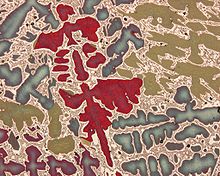
Characterization, when used in materials science, refers to the broad and general process by which a material's structure and properties are probed and measured. It is a fundamental process in the field of materials science, without which no scientific understanding of engineering materials could be ascertained.[1][2] The scope of the term often differs; some definitions limit the term's use to techniques which study the microscopic structure and properties of materials,[2] while others use the term to refer to any materials analysis process including macroscopic techniques such as mechanical testing, thermal analysis and density calculation.[3] The scale of the structures observed in materials characterization ranges from angstroms, such as in the imaging of individual atoms and chemical bonds, up to centimeters, such as in the imaging of coarse grain structures in metals.
While many characterization techniques have been practiced for centuries, such as basic optical microscopy, new techniques and methodologies are constantly emerging. In particular the advent of the electron microscope and secondary ion mass spectrometry in the 20th century has revolutionized the field, allowing the imaging and analysis of structures and compositions on much smaller scales than was previously possible, leading to a huge increase in the level of understanding as to why different materials show different properties and behaviors.[4] More recently, atomic force microscopy has further increased the maximum possible resolution for analysis of certain samples in the last 30 years.[5]
- ^ Kumar, Sam Zhang, Lin Li, Ashok (2009). Materials characterization techniques. Boca Raton: CRC Press. ISBN 978-1420042948.
{{cite book}}: CS1 maint: multiple names: authors list (link) - ^ a b Leng, Yang (2009). Materials Characterization: Introduction to Microscopic and Spectroscopic Methods. Wiley. ISBN 978-0-470-82299-9.
- ^ Zhang, Sam (2008). Materials Characterization Techniques. CRC Press. ISBN 978-1420042948.
- ^ Mathys, Daniel, Zentrum für Mikroskopie, University of Basel: Die Entwicklung der Elektronenmikroskopie vom Bild über die Analyse zum Nanolabor, p. 8
- ^ Patent US4724318 – Atomic force microscope and method for imaging surfaces with atomic resolution – Google Patents